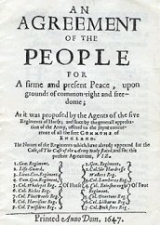
Agreement of the People
Encyclopedia
.jpg)
Manifesto
A manifesto is a public declaration of principles and intentions, often political in nature. Manifestos relating to religious belief are generally referred to as creeds. Manifestos may also be life stance-related.-Etymology:...
s, published between 1647 and 1649, for constitutional changes to the English state. Several versions of the Agreement were published, each adapted to address not only broad concerns but also specific issues during the fast changing revolutionary political environment of those years. The Agreements of the People have been most associated as the manifestos of the Levellers
Levellers
The Levellers were a political movement during the English Civil Wars which emphasised popular sovereignty, extended suffrage, equality before the law, and religious tolerance, all of which were expressed in the manifesto "Agreement of the People". They came to prominence at the end of the First...
but were also published by the Agitators and the General Council of the New Model Army
New Model Army
The New Model Army of England was formed in 1645 by the Parliamentarians in the English Civil War, and was disbanded in 1660 after the Restoration...
.
Major published versions of the Agreement include:
- "An Agreement of the People for a firm and present peace upon grounds of common right", presented to the Army Council in October 1647.
- "An Agreement of the People of England, and the places therewith incorporated, for a secure and present peace, upon grounds of common right, freedom and safety", presented to the Rump ParliamentRump ParliamentThe Rump Parliament is the name of the English Parliament after Colonel Pride purged the Long Parliament on 6 December 1648 of those members hostile to the Grandees' intention to try King Charles I for high treason....
in January 1649. - "AN AGREEMENT OF THE Free People of England. Tendered as a Peace-Offering to this distressed Nation", extended version from the Leveller leaders, "Lieutenant Colonel John LilburneJohn LilburneJohn Lilburne , also known as Freeborn John, was an English political Leveller before, during and after English Civil Wars 1642-1650. He coined the term "freeborn rights", defining them as rights with which every human being is born, as opposed to rights bestowed by government or human law...
, Master William WalwynWilliam WalwynWilliam Walwyn was an English pamphleteer, a Leveller and a medical practitioner.Walwyn was a silkman in London who took the parliamentary side in the English Civil War. He advocated religious toleration and emerged as a leader of the Levellers in 1647 which led to his imprisonment in 1649...
, Master Thomas PrinceThomas PrinceThomas Prince was an American clergyman, scholar and historian noted for his historical text A Chronological History of New England, in the Form of Annals...
, and Master Richard OvertonRichard OvertonRichard Overton was an English pamphleteer and Leveller during the Civil War. Little is known of the early life of Overton, but he is believed to have matriculated at Queens' College, Cambridge, before working as an actor and playwright in Southwark. Here he picked up Leveller sympathies, and...
, Prisoners in the Tower of LondonTower of LondonHer Majesty's Royal Palace and Fortress, more commonly known as the Tower of London, is a historic castle on the north bank of the River Thames in central London, England. It lies within the London Borough of Tower Hamlets, separated from the eastern edge of the City of London by the open space...
, May the 1. 1649."
Soon after the First English Civil War
First English Civil War
The First English Civil War began the series of three wars known as the English Civil War . "The English Civil War" was a series of armed conflicts and political machinations that took place between Parliamentarians and Royalists from 1642 until 1651, and includes the Second English Civil War and...
, the Agreement was the subject of the Putney Debates
Putney Debates
The Putney Debates were a series of discussions between members of the New Model Army – a number of the participants being Levellers – concerning the makeup of a new constitution for England....
in 1647. The major tenets of this first version of the Agreement were: freedom of religion, the frequent convening of a new Parliaments and equality for all under the law. These tenets also appeared in the later versions of the manifesto. As these basic proposals were queried, other provisions were added; for example Roman Catholics were exempt from the right to religious freedom, and the electorate was to be made up of adult male property holders. The Levellers hoped to base England's new constitution
Constitution
A constitution is a set of fundamental principles or established precedents according to which a state or other organization is governed. These rules together make up, i.e. constitute, what the entity is...
on the Agreement of the People, but in the end, the New Model Army
New Model Army
The New Model Army of England was formed in 1645 by the Parliamentarians in the English Civil War, and was disbanded in 1660 after the Restoration...
based their demands on an alternative less revolutionary document, the Heads of Proposals
Heads of Proposals
The Heads Of Proposals was a set of propositions intended to be a basis for a constitutional settlement after King Charles I was defeated in the first English Civil War...
, that was proposed and supported by the Grandees (senior officers) of the Army.
See also
- English Commonwealth
- Instrument of Government

